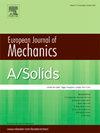A geometrically inspired constitutive framework for damage and intrinsic self-healing of elastomers
IF 4.2
2区 工程技术
Q1 MECHANICS
引用次数: 0
Abstract
Autonomic interfacial self-healing in elastomers enables their reprocessing and recycling, making them valuable for applications such as ballistic resistance, surface coatings, adhesives, and biomedical materials. This article prescribes a geometry-based damage-healing theory for autonomic healing in elastomers, built on a framework where damage induces an incompatibility in the Euclidean material manifold, transforming it into a Riemannian manifold. Healing restores the Euclidean state through a reversing damage variable or an evolving healing variable. The reversing damage variable models the rebonding mechanism while the healing variable accounts for healing by chain diffusion and entanglement. The model also predicts healing in cases where rebonding is preceded by chain diffusion. The microforce balance governs the evolution of the damage and healing variables, capturing rate-dependent damage and intrinsic temperature-independent healing. The model is validated through numerical simulations, including one-dimensional and two-dimensional simulations, demonstrating accurate predictions of coupling between damage and healing and post-healing mechanical response. The model also predicts the recovery of fracture toughness with healing time in supramolecular elastomers, aligning with experimental data. With minimal parameters, the model is versatile and can easily be used for material design and structural analysis, surpassing existing models in simplicity and predictive capability.
弹性体损伤和内在自愈的几何启发本构框架
弹性体中的自主界面自我修复使其能够再加工和回收,使其在抗弹道、表面涂层、粘合剂和生物医学材料等应用中具有价值。本文规定了弹性体自主愈合的基于几何的损伤愈合理论,建立在损伤引起欧几里得材料流形不相容的框架上,将其转化为黎曼流形。治疗通过可逆伤害变量或进化治疗变量恢复欧几里得状态。可逆损伤变量模拟了重键机制,而愈合变量描述了链扩散和缠结的愈合。该模型还预测了在重键之前链扩散的情况下的愈合。微力平衡控制损伤和愈合变量的演变,捕获速率相关的损伤和固有的温度无关的愈合。通过一维和二维数值模拟验证了该模型的有效性,准确预测了损伤与愈合之间的耦合以及愈合后的力学响应。该模型还预测了超分子弹性体断裂韧性随愈合时间的恢复,与实验数据一致。该模型具有最小的参数,可以很容易地用于材料设计和结构分析,在简单性和预测能力方面超越现有模型。
本文章由计算机程序翻译,如有差异,请以英文原文为准。
求助全文
约1分钟内获得全文
求助全文
来源期刊
CiteScore
7.00
自引率
7.30%
发文量
275
审稿时长
48 days
期刊介绍:
The European Journal of Mechanics endash; A/Solids continues to publish articles in English in all areas of Solid Mechanics from the physical and mathematical basis to materials engineering, technological applications and methods of modern computational mechanics, both pure and applied research.

 求助内容:
求助内容: 应助结果提醒方式:
应助结果提醒方式:


